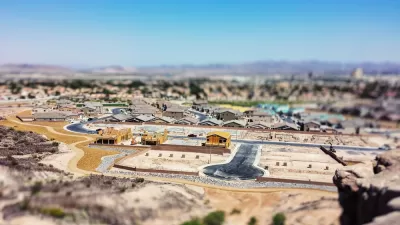In an excerpt from his new book, Bill Fulton suggests that it's time for America's cities to focus on prosperity, not population.
If you think the economic growth figures are sluggish, try looking at the population figures and think about this: Most of America's large metropolitan areas are not growing very fast. But does slow population growth mean they're not going to prosper either? Or is it time for America's cities and metropolitan areas to get serious about "growth without growth"?
According to the Census Bureau, there are 49 metropolitan statistical areas in the United States. Between 2000 and 2009, six of them lost population – led, not surprisingly, by New Orleans. But another seven grew by less than a half-percent a year – including New York, Los Angeles, and Boston. Nine more – including Virginia Beach, Louisville, Memphis, and San Diego – grew by less than one percent a year. And seven more – including Oklahoma City, Seattle, Miami, and Columbus – grew by just a little more than one percent per year.
So, 29 of the 49 largest metro areas in the country are now growing slowly – including the biggest ones, many mature areas in the Northeast and Midwest, and many places we think of as fast-growing Sunbelt cities. Indeed, most of the metros we think of as the drivers of the American economy are now slow-growth places.
Over the past half-century, we have come to equate a stagnating population with a stagnating economy. Orlando and Phoenix are growing fast – so they're prospering. Cleveland and Detroit are losing population fast – so they're in decline.
But with so many metros now slowing down in population growth, maybe it's time to re-think the relationship between economic growth and population growth. Maybe it's time to figure out how to have growth without growth.

Wealth Builders and Population Magnets
A few years ago, Paul Gottlieb, an economist at Case Western Reserve University in Cleveland, took a look at whether growth without growth was possible. He did so by comparing population growth and growth in real per-capita income in the 100 largest metropolitan areas. Most of the results were not surprising. Many thriving metros - Atlanta, Austin, Dallas, Phoenix - were above the national average in both categories. Many struggling ones, including Cleveland itself and all the metropolitan areas in Upstate New York, were below the average in both categories.
Surprisingly however, Gottlieb found that almost half of the 100 largest metro areas fit neither category. They're either "wealth builders" - places such as Chicago, Detroit, Memphis, Pittsburgh and St. Louis - that saw income go up faster than population, or they're "population magnets" - places such as Daytona Beach, El Paso, Knoxville, Orlando and Portland - that saw the reverse.
The "wealth builders" are of particular interest – places where population has slowed down or stagnated, yet are still adding income and wealth. Pittsburgh, for example, has been losing population for decades. Yet nobody thinks of Pittsburgh these days as an economic failure. It's reinvented itself, adjusted to a smaller population, and today thrives on a "new economy" that emerged from the old. St. Louis is the same way.
Indeed, in most cases, the "wealth builders" were older, blue-collar places in the Northeast, the Midwest and the South: Kansas City, Little Rock, Milwaukee, New Orleans, Providence and Tampa.
What is the difference between these cities and the ones that had both low rates of population increase and little economic growth? That is, places such as Buffalo, Hartford, Oklahoma City, Philadelphia and Charleston, West Virginia. After all, both groups of cities have lower educational attainment and strong manufacturing bases. Even more baffling, why are some of these gritty, non-dazzling metropolitan areas doing better on Gottlieb's "growth without growth" index than supposed superstars such as Atlanta, Austin, Las Vegas and Orlando?
The answer appears to be that not adding population has some benefits. First, much of the nation's population growth in recent years has been driven by immigration, and recent immigrants pull down the overall per-capita income. And second, many of the fastest-growing metros - Las Vegas and Orlando among them - have parlayed climate and raw land into a tourism-based economy, which tends to create low-wage jobs.
The "growth without growth" champs, such as St. Louis and Pittsburgh, may experience higher levels of educational attainment and high-tech employment - more than Buffalo and Cleveland, and, at the same time, more than Las Vegas and Orlando.

Does That Mean NIMBYs Are Right?
A lot of people glom on to these statistics for their own purposes. "Slow-growth" politicians where I live in coastal California use it to advocate closing the door to new residents. They say that these statistics reveal that population growth often isn't worth the cost and that just because you stop adding population doesn't mean that you call a halt to prosperity. Indeed, part of Gottlieb's motivation in doing the study seems to have been to challenge conventional wisdom. Limiting population growth doesn't inevitably harm a metropolitan area's prosperity.
But I'm not so sure that this new research supports the slow-growth argument in quite this fashion. Of the 23 "wealth builder" metro areas whose income gains exceeded population growth, the only one engaged in widespread population restrictions as a public policy goal was San Francisco. But San Francisco was the exception rather than the rule. Population may be growing slowly in most of these cities, but the tepid rates are not because of government slow-growth policies.
In Ventura County, California, our local voters are always trying to restrict growth and send surplus residents somewhere else. I've always thought maybe it should be official government policy to ship all those extra folks to Pittsburgh and Detroit and other Rust Belt towns.
Now I'm not so sure. Maybe back in the Rust Belt, they're better off without the rest of us.
William Fulton is a principal at Design, Community & Environment and mayor of Ventura, California. This article is adapted from his new book, Romancing the Smokestack: How Cities and States Pursue Prosperity.

Alabama: Trump Terminates Settlements for Black Communities Harmed By Raw Sewage
Trump deemed the landmark civil rights agreement “illegal DEI and environmental justice policy.”

Planetizen Federal Action Tracker
A weekly monitor of how Trump’s orders and actions are impacting planners and planning in America.

The 120 Year Old Tiny Home Villages That Sheltered San Francisco’s Earthquake Refugees
More than a century ago, San Francisco mobilized to house thousands of residents displaced by the 1906 earthquake. Could their strategy offer a model for the present?

San Francisco Opens Park on Former Great Highway
The Sunset Dunes park’s grand opening attracted both fans and detractors.

Oregon Legislature to Consider Transit Funding Laws
One proposal would increase the state’s payroll tax by .08% to fund transit agencies and expand service.

Housing Vouchers as a Key Piece of Houston’s Housing Strategy
The Houston Housing Authority supports 19,000 households through the housing voucher program.
Urban Design for Planners 1: Software Tools
This six-course series explores essential urban design concepts using open source software and equips planners with the tools they need to participate fully in the urban design process.
Planning for Universal Design
Learn the tools for implementing Universal Design in planning regulations.
Clanton & Associates, Inc.
Jessamine County Fiscal Court
Institute for Housing and Urban Development Studies (IHS)
City of Grandview
Harvard GSD Executive Education
Toledo-Lucas County Plan Commissions
Salt Lake City
NYU Wagner Graduate School of Public Service





























